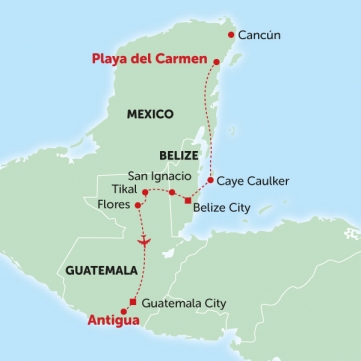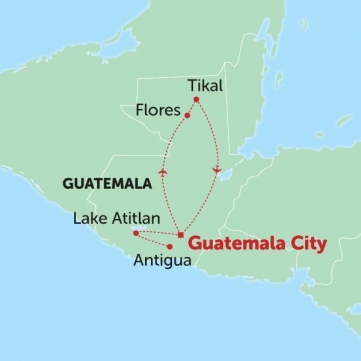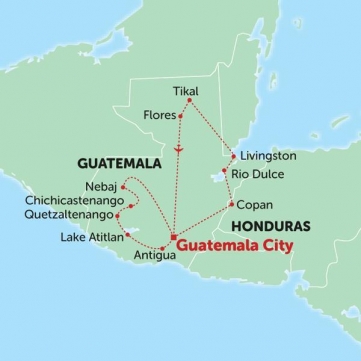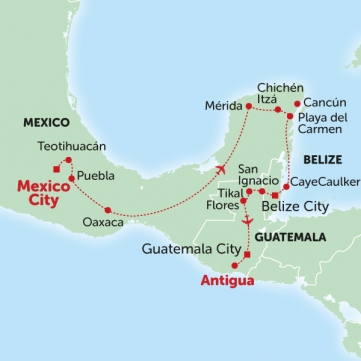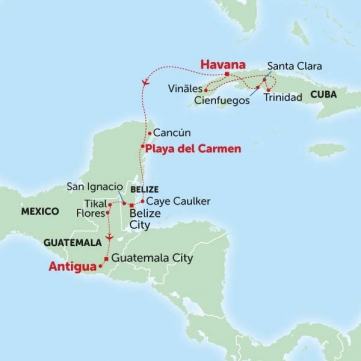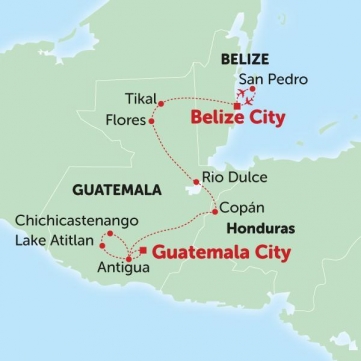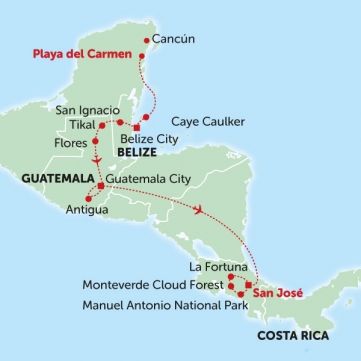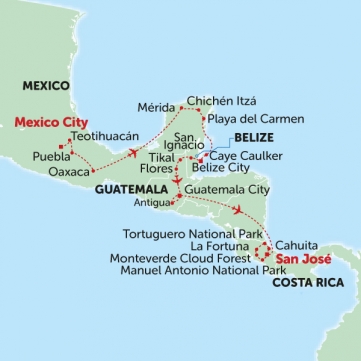Book NOW for $1 £1 €1 • Flexible Payments • No Change Fees • Private Departures Available
- Home >>
- Destinations >>
- Central America >>
- Guatemala
Guatemala Tours
Take a Guatemala adventure tour to this fascinating country bordered by Mexico to the north and Honduras to the south while also bordering Belize and El Salvador plus two oceans! Antigua is one of the most delightful colonial towns in Central America where the local indigenous population line the cobbled streets and plazas in their colourful costumes, selling their crafts and textiles.
Enjoy traditional music, architecture and art with its ornate churches, convents, parks, plazas, cafés, restaurants, bars and colourful street markets and surrounded by awe-inspiring volcanoes. Our Guatemala adventure tours also visit Rio Dulce where we stay in cabins right on the water, and can take a boat tour to Livingston, experiencing some of the most beautiful scenery imaginable, to this lively little town with its Caribbean atmosphere. Flores is our base for exploring the breathtaking Maya jungle site of Tikal, regarded as the greatest city of the Maya world. As you wander the site on your Guatemala adventure tour, you will have the opportunity to climb some of the tallest Mayan temples, as the Maya believed the higher the building, the closer they were to the gods.
All Tours of Guatemala
8 Tours
Guatemala Travel Articles, Inspiration & Information
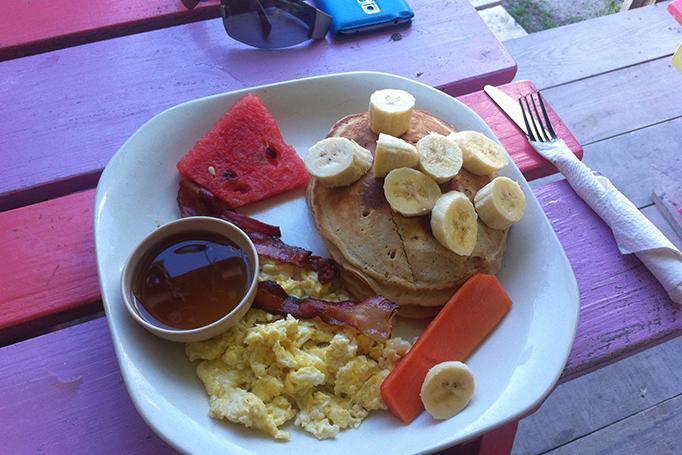
Top 7 dishes of Central America
During Marcus’ adventures across Central America he rounded up some of the best dishes for all the eager foodies out there! Try and get through this post without salivating- we dare you! The local speciality when you’re near the coastal areas of Guatemala is a rich seafood stew called ‘tapado’... Read more
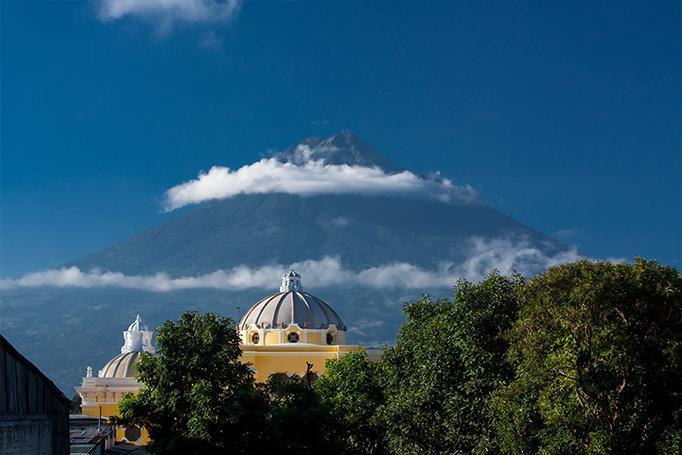
Climbing Volcanoes outside Antigua
As I pulled myself up the steep hill to the next view point, still shrouded in cloud, I wondered really why I was bothering to climb this volcano at all. The tour had arrived in Antigua, a city in the central highlands of Guatemala. The cooler temperatures were definitely welcomed by the group after nine days of humidity. It’s a charming colonial city... Read more
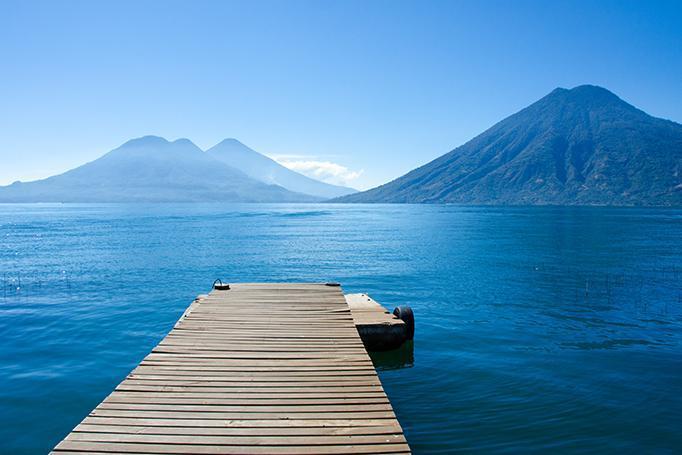
Tour Leader Insights: An Interview on Central America
We have managed to pin down two of our amazing Central America tour leaders for a short interview on a lowdown of their favourite continent, before they go whizzing off taking more excited passengers on an adventure of a lifetime! This article is perfect for anyone planning their next adventure to Central America.. Read more
Independently Verified Travel Reviews From Past Clients
Guatemala Travel Guide
Guatemala Travel Guide
Brief history
The ancient Maya civilization of Guatemala reached its zenith between 250 and 800 AD. The civilisation was still in existence, but was weakened and war-torn when the Spaniards conquered and took control of what is now called Guatemala in 1524. During the colonial period, Spanish-born colonists held the reins of power, but large groups of Creoles (Spaniards born in the New World) and mestizos (those of mixed Spanish and indigenous heritage) also developed. Guatemala gained independence from Spain in the early 1820s and became a republic in 1847.
In late 1996, Guatemala’s civil war ended when a series of agreements were signed between the Guatemalan government and guerrilla insurgents. Over its 36-year history, the war claimed the lives of an estimated 200,000 people. Since the 1996 peace treaty, relations are better between the Maya and the Ladinos (as those of mixed Spanish and Amerindian descent are known).
Geography and weather
There is a rainy season throughout Central America which starts around May/June and gradually works its way through until September and even sometimes October. Don't be put off by the term rainy season, as this generally only means sporadic downpours a couple of times a day. Of course there are times when this is not the case but it is fairly rare for continual rain to persist. The only place where rain is almost guaranteed is Rio Dulce, located in the middle of the rainforest. Here the rainy season sometimes continues till Feb! The temperatures in Guatemala are similar to other northern hemisphere countries, where it's warmer in summer (July/August) and cooler in winter (December/January). In the Guatemalan Highlands temperatures at night time are quite cool (Antigua, Lake Atitlan and especially Quetzaltenango). For example December/January nights in the highlands can drop to zero centigrade. Generally, the hottest time in Guatemala will be the months of April to May (before the rain comes!).
Visit www.worldclimate.com to get an idea of what the weather will be like on your tour.
Jungle Wildlife
If your tour includes a visit to a jungle region you should be prepared to encounter an array of wildlife – including many insects and spiders etc. Most creepy crawlies are completely harmless and will cause you no problems at all – in fact this is all part of the jungle experience. If you find something it your room it certainly doesn't mean that the room is unclean – rather that you are in the jungle and it is completely normal. If you are uncomfortable with creepy crawlies it is a good idea to bring plenty of insect repellent spray and coils to place in your room and of course don't leave any food lying around.
Visas
Most nationals do not need a visa to enter Guatemala, but it is important to check the rules for your nationality with your nearest embassy or consulate. Entry is granted on production of a passport valid for more than 6 months and proof of funds to support yourself (although proof not usually requested). As a tourist you are entitled to 90 days, however depending on the immigration official you may be allocated 30, 60 or 90 days.
You will probably be asked to fill out an immigration card. A copy of this card should stay in your passport until you exit the country.
Money
ALL prices stated in this dossier are given as a guide only and are subject to change. All prices are quoted in US dollars, unless otherwise stated.
The monetary unit in Guatemala is the quetzal, named after the national bird. For up-to-date exchange rates with your own currency visit www.oanda.com or www.xe.com.
US dollars are accepted for some purchases in Guatemala, however you will need quetzales for most purchases. Even if you have the choice of paying for things in dollars it will be in your favour to use local currency. Therefore we advise you to obtain a considerable amount of local currency as soon as you enter the country.
Remember that once out of Guatemala you will generally not be able to use or exchange quetzales (except at the border towns). Therefore you must make sure you spend/exchange/donate any left-over money before leaving the country.
US dollars and travellers cheques can be changed at casas de cambio (exchange bureau), banks and border crossings. Your tour leader will give you details of when and where best to change money. Casas de cambio are privately owned, usually have longer opening hours and attend to you faster than banks.
Often the easiest way to obtain local currency is to use the ATMs (‘cajeros automaticos’) located in every city throughout the country. Visa, Plus, and Cirrus/Maestro are accepted in most Guatemalan ATMs
Although bank cards are often the easiest way to go, there are times where they will not work for you even if your bank at home tells you it will. Do not rely on your card as your only source of money. Always have a few back-ups with you.
In Guatemala you will never be able to use US dollar notes which are torn or marked even slightly. If your notes are at all damaged you may use them in Belize, but not in Guatemala or Mexico.
Travellers cheques can be very time-consuming to cash in Guatemala and many personal details are required. If you choose to take them, make sure they are in US$ and ‘American Express’ cheques (they are by far the most widely accepted).
If you do decide to queue in a bank, always check that what you want to do is going to be possible before lining up. Different banks have different rules. For example some banks do not exchange travellers cheques. They may also have a limit to the amount of US dollars you can exchange. Always try to exchange as much as you can at one time and try to ask cashiers for small notes “billetes pequeñas” as you will find it very difficult to break large notes throughout Latin America.
Always make sure you put your cash inside your money belt before you leave the premises. Pickpockets tend to loiter near banks and change houses.
Tipping
A10% service charge is added on to the restaurant bill throughout most of Guatemala. If it is not added on, it is still expected (especially in the more expensive restaurants). There should be no other charge on top of this. You are not expected to tip taxi drivers unless they go out of their way for you although you should tip anyone who helps with your luggage, approx 50-80cents (Q5). Tipping guides at the end of tours/excursions is always appreciated and your tour leader will advise you on this.
Security
Crime in Latin America is not as bad as its reputation as long as you are sensible and alert. Like anywhere in the world, you can be in the wrong place at the wrong time. Care should be taken, especially whilst walking around the larger cities. Try to keep away from dark quiet areas if on your own, particularly late at night and try to always take a taxi.
We suggest that whenever possible you leave all of your important documents in the safe (“caja fuertes”). However you should always carry some form of ID or a photocopy of your passport.
It is advisable not to wear expensive looking watches or jewellery. Keep your camera concealed when not in use. Remember that most thieves don't use violence but rely mostly on diversionary tactics which can take place at anytime of the day or night. Do not be paranoid, but just be aware that it could happen at anytime. Always be vigilant and the chances are nothing will ever happen to you. The safety of our passengers is our tour leaders’ number one concern and they will provide all necessary local information during the pre-departure meeting.
Local food and drink
People are often surprised by the quality and variety on offer in Guatemala This is partly due to the number of ex-pats who have opened up a range of different international restaurants. There is also local cuisine to suit every budget. Chicken, pork and beef are available throughout. Most meals come with corn tortillas and sometimes salad, but often lack hot vegetables. Although you might expect the food to be spicy in this region (‘picante’ in Spanish), this is not usually the case.
Your tour leader will be able to recommend restaurants.
Corn (maize), is the staple diet of Guatemala’s indigenous people and you will certainly get a lot of it. Mostly in the form of tortillas which are flat pancake-like things made of corn dough and grilled. The following are a few Guatemalan specialties:
Guatemalan Enchiladas - Different to the Mexican enchiladas, these ones are more like western taco shells topped with chichen/pork, salad and cream. Very tasty. You can buy three for about US$2
Bistec or Pollo Asado - Beef steak or grilled chicken. These are common meals, usually served with tortillas, rice, spring onion, white cheese, and salad. Prices average from US$3-$5. Note that steak in Guatemala tastes good, but can be very tough.
Platanos Asados - (roasted bananas) These are topped either with sugar or cream (or both) for less than US$1 a serving. Keep in mind that the bananas aren't bananas proper...they are a type of plantain, very sweet tasting and are also often served with savoury meals.
If you have any allergies to foods, please come prepared with a list to give to your tour leader who can then translate it into Spanish for you to show every waiter who takes your order. If you are vegetarian you must always specify ‘no carne, puerco, pollo, pescado’ etc etc.
In general we do not recommend you buy food off the street, however your tour leader will give advice, e.g. certain streets in Antigua where the local ladies prepare everything well. If you are unsure just try to use common sense and avoid any food that has been sitting around for a long time (and a word of advice – avoid the bright yellow hot chips sold on every road-side).
If you are a strict vegetarian you may experience a distinct lack of variety in the food available, especially in small towns. You might find that you are eating a lot of omelettes and other egg dishes. Our tour leaders will do their best to provide interesting vegetarian alternatives when arranging group meals in the campsite, but your patience and understanding is requested.
Guatemalan fruit is fresh and cheap. Go to one of the many juice stands and ask for a “liquado de fruta” (fruit smoothie) or “jugo de naranja y zanahoria” (orange & carrot). Papaya, melon, watermelon, mango, and pineapple are very popular, but you can also get fun things like celery, beetroot, & chaya (a spinach-like leaf). Liquados can be made with either water or milk. Always specify if you don’t want sugar (“sin azucar”). Latin Americans have a very sweet tooth and will usually automatically add the sugar!
Coke and Pepsi are everywhere. You will also find all sorts of orange, grape, lemon, and lime soft drinks (“Gaseosas”). “Agua Mineral” is sparkling water.
Generally speaking it’s best not to expect good coffee/tea in this part of the world. Be warned that Americano (weak black coffee) is the most common, followed by “café con leche” (more like milk with a bit of coffee), and cappuccino (sometimes good). If you ask for tea (“té negro”) you will get teabags. Always ask for “leche fria a parte” (cold milk on the side) as the alternative is likely to be a hot cup of milk with a tea bag inside.
If you only learn one word in Spanish it’s bound to be “Cerveza”. There are countless lagers, and a few dark beers. A beer will cost you anywhere between US$1.50 and $3. The most common are ‘Gallo’ and ‘Tona’, with the more premium ones being ‘Modelo’ and ‘Dorada’.
White rum (ron) are definitely the most commonly drunk spirit in Guatemala. Guatemala is not known for its wine and it is best to order Chilean wine.
Time Difference
The time difference in Guatemala is GMT/UTC - 6. For other time differences please visit www.timeanddate.com
Voltage
110 volts, US-style two pronged plugs



